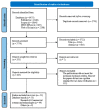Contactless Technologies, Sensors, and Systems for Cardiac and Respiratory Measurement during Sleep: A Systematic Review
- PMID: 37299762
- PMCID: PMC10255824
- DOI: 10.3390/s23115038
Contactless Technologies, Sensors, and Systems for Cardiac and Respiratory Measurement during Sleep: A Systematic Review
Abstract
Sleep is essential to physical and mental health. However, the traditional approach to sleep analysis-polysomnography (PSG)-is intrusive and expensive. Therefore, there is great interest in the development of non-contact, non-invasive, and non-intrusive sleep monitoring systems and technologies that can reliably and accurately measure cardiorespiratory parameters with minimal impact on the patient. This has led to the development of other relevant approaches, which are characterised, for example, by the fact that they allow greater freedom of movement and do not require direct contact with the body, i.e., they are non-contact. This systematic review discusses the relevant methods and technologies for non-contact monitoring of cardiorespiratory activity during sleep. Taking into account the current state of the art in non-intrusive technologies, we can identify the methods of non-intrusive monitoring of cardiac and respiratory activity, the technologies and types of sensors used, and the possible physiological parameters available for analysis. To do this, we conducted a literature review and summarised current research on the use of non-contact technologies for non-intrusive monitoring of cardiac and respiratory activity. The inclusion and exclusion criteria for the selection of publications were established prior to the start of the search. Publications were assessed using one main question and several specific questions. We obtained 3774 unique articles from four literature databases (Web of Science, IEEE Xplore, PubMed, and Scopus) and checked them for relevance, resulting in 54 articles that were analysed in a structured way using terminology. The result was 15 different types of sensors and devices (e.g., radar, temperature sensors, motion sensors, cameras) that can be installed in hospital wards and departments or in the environment. The ability to detect heart rate, respiratory rate, and sleep disorders such as apnoea was among the characteristics examined to investigate the overall effectiveness of the systems and technologies considered for cardiorespiratory monitoring. In addition, the advantages and disadvantages of the considered systems and technologies were identified by answering the identified research questions. The results obtained allow us to determine the current trends and the vector of development of medical technologies in sleep medicine for future researchers and research.
Keywords: cardiac activity; contactless technologies; health monitoring systems; respiratory activity; sensors; sleep measurements; sleep monitoring systems.
Conflict of interest statement
The authors declare no conflict of interest.
Figures









References
-
- De Fazio R., Stabile M., De Vittorio M., Velázquez R., Visconti P. An Overview of Wearable Piezoresistive and Inertial Sensors for Respiration Rate Monitoring. Electronics. 2021;10:2178. doi: 10.3390/electronics10172178. - DOI
-
- Inan O.T., Migeotte P.-F., Park K.-S., Etemadi M., Tavakolian K., Casanella R., Zanetti J., Tank J., Funtova I., Prisk G.K., et al. Ballistocardiography and Seismocardiography: A Review of Recent Advances. IEEE J. Biomed. Health Inform. 2014;19:1414–1427. doi: 10.1109/JBHI.2014.2361732. - DOI - PubMed
Publication types
MeSH terms
Grants and funding
LinkOut - more resources
Full Text Sources

